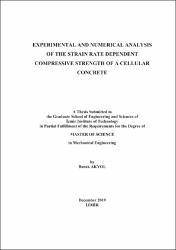Please use this identifier to cite or link to this item:
https://hdl.handle.net/11147/9652Full metadata record
| DC Field | Value | Language |
|---|---|---|
| dc.contributor.advisor | Güden, Mustafa | - |
| dc.contributor.advisor | Taşdemirci, Alper | - |
| dc.contributor.author | Akyol, Burak | - |
| dc.date.accessioned | 2020-09-04T08:20:31Z | |
| dc.date.available | 2020-09-04T08:20:31Z | |
| dc.date.issued | 2019-12 | - |
| dc.identifier.citation | Akyol, B. (2019). Experimental and numerical analysis of the strain rate dependent compressive strength of a cellular concrete. Unpublished master's thesis, İzmir Institute of Technology, İzmir, Turkey | en_US |
| dc.identifier.uri | https://hdl.handle.net/11147/9652 | - |
| dc.description | Thesis (Master)--Izmir Institute of Technology, Mechanical Engineering, Izmir, 2019 | en_US |
| dc.description | Includes bibliographical references (leaves: 103-108) | en_US |
| dc.description | Text in English; Abstract: Turkish and English | en_US |
| dc.description.abstract | Experimental and numerical quasi-static and high strain rate tests, including compression, indentation and direct impact, were performed on a cellular concrete in order to investigate the effect of strain rate on the compressive strength. The results of compression tests indicated three distinct regions of the compressive strength dependence on strain rate. A relatively lower strain rate dependent compressive stress was found in the quasi-static strain rate-regime, 2x10-3-2x10-1 s-1, a relatively high strain rate dependent compressive stress in the dynamic strain rate-regime, 180-103 s-1 and a cut-off strength above 103 s-1. The dynamic increase factor (DIF=dynamic/static fracture strength) varied between 1 and 2.5 from quasi-static to dynamic strain rate-regime with a sharp increase after about 100 s-1. The indentation tests using 25 and 30 mm-diameter indenters in the quasi-static strain rate-regime (uniaxial state of strain) and resulted in moderate DIF values (1-1.13), very similar with those of the quasi-static compression tests (1-1.15). In the indentation tests, the DIF values significantly and also confirmed the numerically determined DIF values of concrete at 1000 s-1 (~1.30) without radial and axial inertia. The compression and direct impact tests in the Split Hopkinson Bar (SHPB) set-up were implemented numerically in LS-DYNA using an anisotropic strain rate insensitive material model, MAT_096 (MAT BRITTLE DAMAGE). The stress readings were performed at the specimen different locations of the SHPB and indicated that radial and axial inertia were dominant between 1 and 30 m s-1 (30-1000 s-1). | en_US |
| dc.description.abstract | Gaz betonlar basma, girinti ve direkt çarpma yöntemleriyle deneysel ve nümerik olarak yarı-statik ve yüksek deformasyon hızlarında test edilmiş ve deformasyon hızının basma mukavemeti üzerindeki etkisi gözlemlenmiştir. Basma testleri sonucunda deformasyon hızına bağlı üç farklı basma mukavemeti bölgesi belirlenmiştir. Yarı-statik deformasyon hızında daha düşük hıza dayalı mukavemet artışı gözlenirken (2x10-3- 2x10-1 s-1), yüksek deformasyon hızlarında yapılan testlerde daha yüksek hıza dayalı mukavemet artışı olduğu saptanmıştır (180 s-1-103 s-1). 103 s-1 deformasyon hızından sonra mukavemet artışı sabit kalmıştır. Yüksek deformasyon hızlarındaki mukavemetin yarı-statik deformasyon hızlarındaki mukavemete oranı Dinamik Artış Faktörü (DAF) olarak tanımlanmaktadır. Söz konusu oran yapılan çalışmalar sonucunda 1-2.5 arasında çıkmış ve 100 - 1000 s-1 deformasyon hızlarında ani bir artış göstermiştir. 25 ve 30 mm basma uçlarıyla yarı-statik deformasyon hızlarında yapılan girinti testleri makul bir DAF oranı (1-1.15) ile tek eksenli gerinim durumu sağlamış ve basma testlerinin yarıstatik deformasyon hızlarındaki DAF'a (1-1.13) benzer bir sonuç göstermiştir. Deneysel sonuçlar girinti testlerinin DAF'ı düşürdüğünü göstermiştir. Deformasyon hızı etkisinin girilmediği nümerik çalışmalarda 1000 s-1'deki DAF'ın 1.30 olduğu gözlenmiştir. Deneysel basma testleri nümerik olarak LS-DYNA ile deformasyon hızı etkisi olmayan anizotropik malzeme modeli MAT_096 (MAT BRITTLE DAMAGE) kullanılarak modellenmiştir. Farklı hızlardaki mukavemet, numune-bar temas alanındaki merkez ile yüzey elemanlarından ve deneysel çalışmalardaki gerinim ölçerin bulunduğu konumdaki elemandan belirlenmiştir. Radyal ve eksenel ataletin 1 ve 30 m s-1 çarpma hızlarında (30-1000 s-1) mukavemet üzerinde etkili olduğu gözlemlenmiştir. | en_US |
| dc.format.extent | xv, 108 leaves | - |
| dc.language.iso | en | en_US |
| dc.publisher | Izmir Institute of Technology | en_US |
| dc.rights | info:eu-repo/semantics/openAccess | en_US |
| dc.subject | Cellular concrete | en_US |
| dc.subject | Strain rate | en_US |
| dc.subject | Experimental analysis | en_US |
| dc.subject | Numerical analysis | en_US |
| dc.title | Experimental and Numerical Analysis of the Strain Rate Dependent Compressive Strength of a Cellular Concrete | en_US |
| dc.title.alternative | Gaz Betonun Deformasyon Hızına Bağlı Basma Mukavemetinin Deneysel ve Nümerik Analizi | en_US |
| dc.type | Master Thesis | en_US |
| dc.institutionauthor | Akyol, Burak | - |
| dc.department | Thesis (Master)--İzmir Institute of Technology, Mechanical Engineering | en_US |
| dc.relation.publicationcategory | Tez | en_US |
| dc.identifier.wosquality | N/A | - |
| dc.identifier.scopusquality | N/A | - |
| item.openairecristype | http://purl.org/coar/resource_type/c_18cf | - |
| item.cerifentitytype | Publications | - |
| item.fulltext | With Fulltext | - |
| item.languageiso639-1 | en | - |
| item.grantfulltext | open | - |
| item.openairetype | Master Thesis | - |
| Appears in Collections: | Master Degree / Yüksek Lisans Tezleri | |
Files in This Item:
| File | Description | Size | Format | |
|---|---|---|---|---|
| 10183650.pdf | MasterThesis | 33.12 MB | Adobe PDF |  View/Open |
CORE Recommender
Page view(s)
288
checked on May 5, 2025
Download(s)
244
checked on May 5, 2025
Google ScholarTM
Check
Items in GCRIS Repository are protected by copyright, with all rights reserved, unless otherwise indicated.